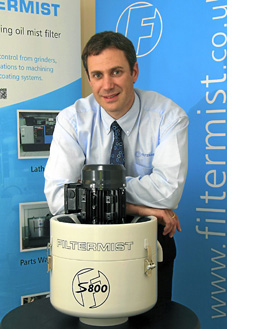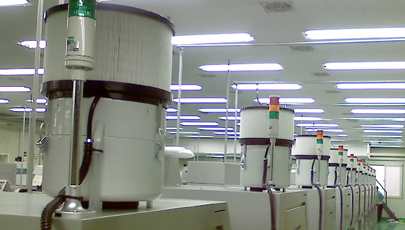British oil mist removal specialist, Filtermist International, is calling for all manufacturers that use metalworking fluids to take responsibility for protecting people from harmful airborne mist particles by installing effective air extraction and filtration.
Despite the rapidly increasing use of metalworking fluids since the early 1800s when the first lathe was invented, it is only in the last 30 years or so that the dangers of exposing workers to hazardous airborne substances have become widely recognised, and legislation and guidance designed to protect workers has been put in place.
Exposure to airborne oil mist particles can cause a number of occupational diseases including skin conditions, respiratory problems and even cancer.
 Filtermist Managing Director, James Stansfield, says, “In an ideal world we would like to see effective oil mist filters fitted as standard to all machine tools.
Filtermist Managing Director, James Stansfield, says, “In an ideal world we would like to see effective oil mist filters fitted as standard to all machine tools.
"However, we realise that this is not always possible for a variety of reasons, so we want to raise awareness amongst the world’s global manufacturing community of the importance of investing in oil mist removal equipment that works.”
What is oil mist?
Oil mist is created when metalworking fluids are sprayed by machine tools to help lubricate the tool or keep metal components cool. Industrial lubricants are used in a variety of manufacturing processes including milling, drilling, grinding, turning and finishing operations.
Manufacturers initially used water to cool the surface of the metal and then moved on to other types of lubrication, including lard, as speeds and efficiencies increased. Today’s modern machine shops use a variety of fluids depending on the purpose of the application.
There are four basic types of metalworking fluids used to keep metal cool during manufacturing processes: Straight Oils, also known as ‘cutting’ or ‘neat’ oils; Soluble Oils; Semi-synthetic Fluids and Synthetic Fluids. Each has its own specific properties and is more suitable in certain applications, but they all have one thing in common – they all generate airborne mist particles when sprayed.
Particle size
Oil mist particles which are larger than 3.5 microns in size are separated in the nose and throat, whilst particles smaller than 1 micron are absorbed into the bloodstream. Particles between these sizes are retained by the throat, bronchial tubes and lungs, causing a variety of occupational diseases. To put this into perspectve, the diameter of an average human hair is between 10 and 50 microns.
Health and Safety legislation
In Britain, the Health and Safety Executive (HSE) introduced the Control of Substances Hazardous to Health (COSHH) regulations in 1988, the same year that Doctors Robertson, Weir and Burge from the Occupational Lung Disease Unit at what was then known as East Birmingham Hospital, published their report into Occupational Asthma due to Oil Mists.
This report details the findings of an investigative study into possible work related asthma. The report’s authors studied 25 patients who were exposed to a variety of oil mists at their place of work and concluded that 52% had asthma which was definitely work related, with a further 28% whose asthma may have been work-related, but could not be definitively proven.
The UK’s HSE published its HSG258 Controlling Airborne Contaminants at Work guidelines in 2008, replacing HSG37 - an introduction to local exhaust ventilation and HSG54 - maintenance, examination and testing of local exhaust ventilation.
The introduction of COSHH regulations and HSG258 guidelines has undoubtedly reduced the number of machine operators affected by exposure to oil mist, but occupational disease is still a major issue. According to the HSE’s ‘Work-related respiratory disease in Great Britain 2014’ report, an estimated 33,000 people who worked in the last 12 months ‘currently have breathing or lung problems caused or made worse by work. An estimated 141,000 people who have ever worked currently have breathing or lung problems caused or made worse by work.’ 10% of these cases are attributed to ‘Airborne materials while welding, soldering, or cutting/grinding metals’.
Minimising health hazards
The World Health Organisation’s Occupational Health – a manual for primary healthcare workers includes details on the Primary prevention of occupational diseases such as those caused by exposure to airborne oil mist:
‘Primary prevention is accomplished by reducing the risk of disease. In the occupational setting this is most commonly done by reducing the magnitude of exposure to hazardous substances. As the dose is reduced, so is the risk of adverse health consequences. Such reductions…are best accomplished by changes in production process or associated infrastructure. Eg…special ventilation of equipment or processes that liberate airborne hazards.’
Additional risks posed by airborne oil mist
In addition to the hazards oil mist poses to human health, oil mist is also a fire risk and can cause slips and falls if droplets are allowed to build up on surfaces where workers walk. Accumulation on sensitive electronic apparatus can cause equipment to fail, interrupting production and resulting in costly downtime.
Oil mist removal
Some manufacturers rely on general ventilation, but it is widely recognised that local exhaust ventilation (LEV) which captures, contains and treats contaminated air at source before it has an opportunity to escape into the wider working environment is a far more effective method of removing oil mist.
LEV extraction system options
Manufacturers can choose from standalone systems which consist of one or more oil mist filters located on or next to each individual machine tool, or they can opt for centralised extraction systems.
Both have their own merits, depending on the nature of the business. For example, some aerospace manufacturers prefer standalone systems as this approach allows the flexibility for their workshops to be re-configured for different projects if required. Automotive manufacturers on the other hand often choose centralized extraction systems as their production lines are static.
As with any other machinery, LEV systems should be regularly checked by a competent person to ensure they are performing as intended.
Oil mist removal using LEV systems
There are currently three methods used to collect and remove oil mist generated by machine tools; static filter media, electrostatic and rotating filter units that use centrifugal force - each method has its own attributes.
Static filter media
Units that use static filter media are generally used for high-volume applications and widely used in centralised extraction systems. Air is drawn into the unit, heavier particles fall to the bottom and are pumped out for collection or re-use. Polluted air then travels up through the first filter cassette which traps smaller particles and if necessary, a further filtration process can be included in particularly demanding applications.
Electrostatic filters
Electrostatic filters use an ioniser that produces an electro static charge which collects and traps air pollutants on an internal baffle plate. This type of filter is very effective for welding fume and smoke applications, but not so good for oil mist as the mist can build up on the plates quite quickly. This reduces the amount of airborne contaminants that are effectively captured so the units need regular cleaning to ensure they are operating efficiently.
Centrifugal force
 Centrifugal force is a proven method which is trusted by some of the world’s leading manufacturers to keep the air in their machine shops clean. A perforated drum with specially designed vanes rotates at high speed. Oil mist is drawn into the unit and impacts on the vanes at high velocity.
Centrifugal force is a proven method which is trusted by some of the world’s leading manufacturers to keep the air in their machine shops clean. A perforated drum with specially designed vanes rotates at high speed. Oil mist is drawn into the unit and impacts on the vanes at high velocity.
Special drum pads assist the coalescing process and filter out stray particles. Centrifugal force pushes oil to the unit’s outer case where it drains back to the machine for re-use or collection and clean air is returned to the workshop through the top of the unit.
James Stansfield sums up, “All employers have a responsibility to protect their workforce from hazards that can lead to occupational diseases. Filtermist has worked in this industry for almost 50 years and we still see examples of workers subjected to contaminated air – even in the UK where the HSE imposes strict regulations.
“However, the introduction of targeted guidelines and legislation around the world appears to be having a positive effect on workers’ health. We hope that one day all machine shops will be free from oil mist contamination. The means are there, but the global manufacturing industry as a whole needs to make sure that employers are educated about the dangers of oil mist and the relative ease with which the problem can be resolved.”
Further reading
Metalworking Fluids: Safety and Health Best Practices Manual, published by the USA’s Occupational Health and Safety Administration (OSHA,) contains a wealth of information including details on how to protect workers from hazards associated with exposure to metalworking fluids.
Filtermist centrifugal oil mist collectors are sold in 60 countries worldwide - find your local distributor by using the dropdown menu at the top of this page.